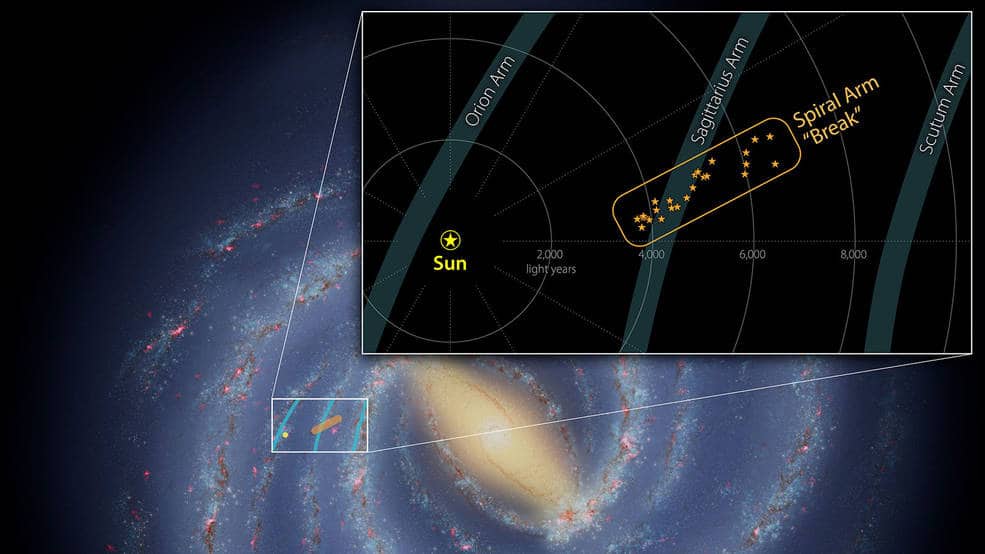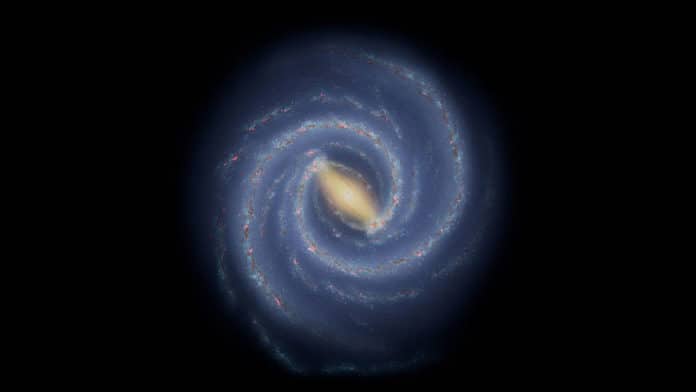For the first time, NASA scientists have identified previously unknown features of the Milky Way galaxy. This previously unrecognized feature is the first significant structure that stretches some 3,000 light-years. This structure is a contingent of young stars and star-forming gas clouds. It appears as the gas cloud is sticking out of one of the Milky Way’s spiral arms like a splinter poking out from a plank of wood.
As the earth is inside the Milky Way, astronomers don’t have enough information on the size and shape of the Milky Way’s arms.
For this study, scientists focused on one of the galaxy’s arms, called the Sagittarius Arm. Using NASA‘s Spitzer Space Telescope before its retirement in January 2020, they sought out newborn stars nestled in the gas and dust clouds (called nebulae) where they form.
Young stars and nebulae are thought to align closely with the shape of the arms they dwell in. By referring to data from the ESA (European Space Agency) Gaia mission that measures distances to the stars, scientists created a 3D view of the arm segment. They found that the long, thin structure in Sagittarius Arm consists of many young stars. These stars are moving at nearly the same velocity and in the same direction through space.

Scientists found that the new structure has four nebulae: the Eagle Nebula (which contains the Pillars of Creation), the Omega Nebula, the Trifid Nebula, and the Lagoon Nebula.
Michael Kuhn, an astrophysicist at Caltech and lead author of the new paper, said, “A key property of spiral arms is how tightly they wind around a galaxy. The arm’s pitch angle measures this characteristic. A circle has a pitch angle of 0 degrees, and as the spiral becomes more open, the pitch angle increases. Most models of the Milky Way suggest that the Sagittarius Arm forms a spiral that has a pitch angle of about 12 degrees, but the structure we examined stands out at an angle of nearly 60 degrees.”
For the study, scientists also leaned on the Galactic Legacy Infrared Mid-Plane Survey Extraordinaire (GLIMPSE). GLIMPSE is a catalog of more than a hundred thousand newborn stars discovered by Spitzer in a galaxy survey.
Co-author Alberto Krone-Martins, an astrophysicist and lecturer in informatics at the University of California, Irvine, and a member of the Gaia Data Processing and Analysis Consortium (DPAC), said, “Distances are among the most difficult things to measure in astronomy. It is only the recent, direct distance measurements from Gaia that make the geometry of this new structure so apparent.”
Kuhn said, “When we put the Gaia and Spitzer data together and finally see this detailed, three-dimensional map, we can see that there’s quite a bit of complexity in this region that just hasn’t been apparent before.”
Even though we can’t see the Milky Way’s full structure, the ability to measure the motion of individual stars is useful for understanding this phenomenon: The stars in the newly discovered structure likely formed around the same time, in the same general area. Also, they are uniquely influenced by the forces acting within the galaxy.
Journal Reference:
- M. A. Kuhn, R. A. Benjamin, et al. A high pitch angle structure in the Sagittarius Arm. DOI: 10.1051/0004-6361/202141198
